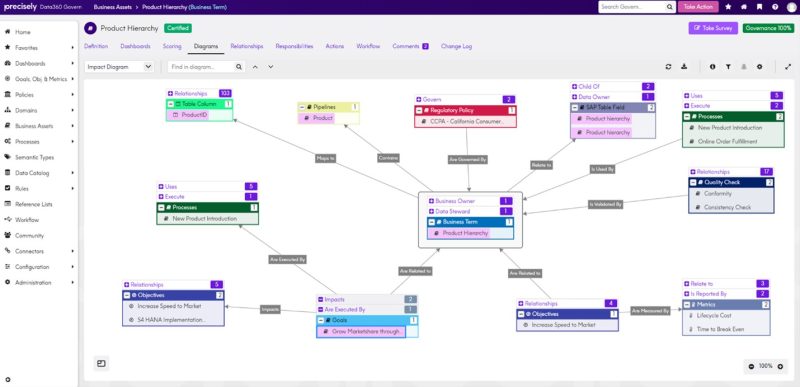
Leading Practices for CPG Data Governance & Quality

The consumer packaged goods (CPG) industry is in the midst of a transformation.
The rise of ecommerce, rapidly advancing technologies, changing consumer behavior, and the arrival of big data have all tipped data strategy from a competitive advantage, to a business imperative.
In CPG, data governance and quality have been, and will continue to be, instrumental in an organization’s ability to survive and thrive in this highly competitive industry. Let’s explore the current state of the CPG in more detail, and discover the best practices for companies to follow for better business intelligence that drives revenue and growth.
Navigating the Changing CPG Landscape
With the increasing popularity of digital commerce among consumers, CPG companies have had to swiftly adapt and abandon their traditional brick-and-mortar comfort zones.
As digital transformation takes hold, implementing new tactics and technologies will enable organizations to leverage data more impactfully, regardless of their channel strategy.
Turning this raw CPG data into trustworthy, actionable business intelligence helps companies identify opportunities, achieve critical objectives, and better compete in the emerging ecommerce arena. But to do so, companies need to innovate their data strategy and capabilities to enable necessary changes to long-standing business models, processes, and corporate culture.
CPG companies are also experiencing the effects of the consolidation of businesses in the space.
Mergers and acquisitions (M&A) activity in this market has seen explosive growth in recent years, sparked by the initial reluctance of many larger CPG companies to enter the online marketplace.
It’s a void that small startups have been more than happy to fill – offering innovative new products and approaches that also made them attractive acquisition targets. Larger CPG’s have been acquiring these companies at a frenzied pace to expand product offerings, target new consumer audiences, reach emerging markets, increase distribution channels, and elevate their digital strategy.
But, like digital transformation, M&A also presents complex data challenges for these acquiring organizations who need to consolidate systems and infrastructure, streamline processes, and eliminate redundancies.
Whether the initiative is digital transformation or M&A consolidation, companies face many of the same challenges and require an enterprise data strategy to overcome them. They must define and prioritize key business objectives, evaluate the current state and gaps of their digital landscape, identify business-critical data processes and assets, and develop a plan for execution.
To be successful, any digital strategy must be rooted in a foundation of data governance.
Read our eBook
4 Keys to Improving Data Quality
This eBook will guide you on how to overcome the root problems of data quality, not just identifying specific types and patterns of quality problems, but also clarifying the roles of data quality management and data governance in resolving them.
Surveying the CPG Data Terrain
As CPG companies look to transition to a data-driven business model, strengthen their digital strategy, and/or bring together disparate systems and processes, they must first survey their data landscape. They need five basic capabilities to consistently answer critical questions:
1. The “whys” for change
Which meaningful business outcomes does the organization wish to achieve by leveraging data as a strategic asset? (e.g., accelerating M&A customer and supply chain synergies, accelerating time to market for new products, reducing days that sales are outstanding, removing wasteful spend)
2. Value measurement framework
How will we consistently measure our success in attaining those outcomes? (e.g., KPI’s, metrics, process performance measures, risk exposure/tolerances)
3. Critical data focus
What specific data assets are most critical to key business processes? (e.g., the ability to discover, govern and control the 1-5 % of our data that drives 80%+ of our business decisions and outcomes)
4. Sponsorship & ownership
Who are the critical data owners and stakeholders for setting data strategy? (e.g., CxOs, line of business leaders, process & functional SMEs, data stewards & maintainers)
5. Cohesive strategy & operational plans
By when can we expect to see demonstrable success for our initiative(s)? (e.g., strategic program roadmap, operational data migration plans for systems consolidation, tactical data cleansing initiatives to eliminate data quality vulnerabilities within the data supply chain)
Once a company has completed their assessment and set priorities and objectives, they must establish a solid framework of data governance in which to execute their strategy.
Establishing Enterprise Data Governance
For companies in CPG, data governance is the foundation they need to meet their desired data-powered outcomes and objectives – regardless of what those may be.
Data governance refers to the formal orchestration of people, processes and technology that allow organizations to leverage data as an enterprise asset.
Effective data governance assigns ownership and accountability among data owners, stewards, and stakeholders, establishes a central repository of accessible data sets and sources, and allows data consumers to easily understand and leverage the most relevant assets for analysis and reporting.
Data governance features critical capabilities to develop enterprise data literacy and ensure that everyone is speaking the same data language. Business glossaries define data, terms and business attributes; data dictionaries detail data sources, usage and flow within systems and processes; and data lineage traces data origin and flow through systems and processes.
Here’s an example of how some of our clients crystalize a 360 view of their most critical data:

Together, these governance capabilities enable organizations to achieve critical business outcomes in areas such as system and data migration, process optimization, omni-channel sales, product transparency or growth strategies.
But data governance provides the framework for success; the other essential element is data quality.
Integrating Data Quality
There’s little point to governing CPG data that’s inconsistent, inaccurate, or irrelevant.
Bad data will sit untrusted and unused – or worse yet, it will generate faulty analysis and lead to flawed business decisions. That’s why it’s critical that data governance efforts include integrated data quality to protect and improve the accuracy of data across the data supply chain.
CPG organizations need to evaluate data quality levels across both environments and processes, and identify where data is most at risk.
Implementing data integrity checks for data accuracy, consistency, completeness, and timeliness can protect data quality as data flows through systems and processes. More advanced quality rules for automated reconciliation and transaction tracking can also be used to provide end-to-end data validation throughout the organization, building trust and data value.
So ultimately, what’s the size of the prize for organizations doing all of this well?
Recent benchmarks with our customers have proven the possibility of 25-30% reduction in new product introduction cycle times, improved PMO capacity upwards of 20%, and the ability to remove millions in wasted spend or missed discounts with strategic suppliers.
Beyond quality checks and rules, machine learning may also be used to monitor and improve data quality levels, and implement data quality scores to build consumer trust around data assets’ fitness for purpose and reliability.
As the dynamic market continues its evolution, CPG data must play an essential role in migrating systems, driving product transparency, and ultimately increasing revenue.
Data governance done right, with integrated data quality, increases operational efficiencies, lowers costs, optimizes processes, and allows organizations to derive maximum value from their strategic data assets.
To learn more read our eBook “4 Keys to Improving Data Quality“, which will guide you on how to overcome the root problems of data quality, not just identifying specific types and patterns of quality problems, but also clarifying the roles of data quality management and data governance in resolving them.


